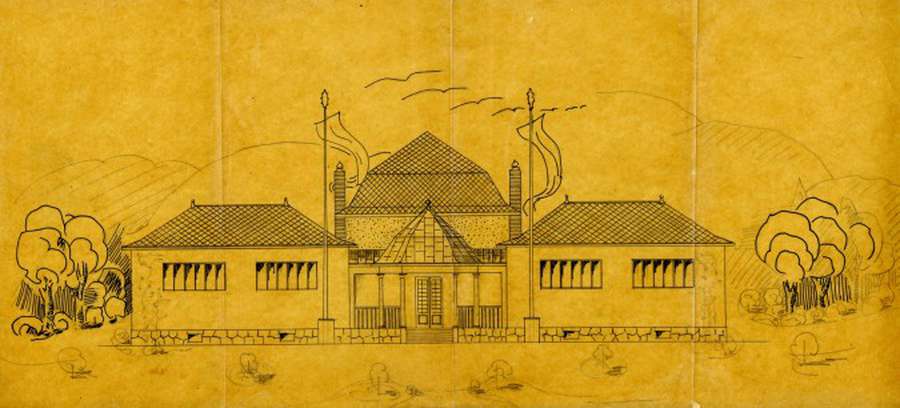Fabiani's Heritage in Ljubljana
In 2015 we are celebrating the 150th anniversary of Max Fabiani’s birth. The museum is commemorating the anniversary of the famous architect and urban planner with Fabiani’s Legacy in Ljubljana. The exhibition presents Fabiani’s regulation plans that outlined the long-term urban development of Ljubljana after the 1895 earthquake, as well as his other executed works in Ljubljana.
URBANIST MAX FABIANI
After the devastating earthquake which struck Ljubljana on 14 April 1895, the city council decided to contract a general regulatory plan for the city. Most of the buildings were damaged, and 10% of them had to be razed to the ground, providing an opportunity to completely redesign the city. Camillo Sitte was the architect chosen among the proposed urbanists, but Fabiani also submitted a plan at his own initiative and cost. His idea was very well suited to the character and the needs of the city, but it was not officially adopted. On 23 January 1896, the city council adopted a regulatory plan for Ljubljana, drafted at the city’s architectural bureau under the leadership of Jan Duffé, heeding Fabiani’s recommendations to a large degree.
Fabiani thoroughly laid out his vision for the urban development of Ljubljana in a brochure entitled Regulation of the Regional Capital City of Ljubljana. Its three hundred copies were published in a booklet in 1895, and the brochure is considered the first text on urbanism written in the Slovenian language.
Fabiani’s plan conformed to the historically concentric design of the city, with the castle in the middle. He highlighted his concept by directing views from all parts of the city towards the castle and designing a radial system of streets outside the city center, without interfering with the historical heart of the city. The most important new element of the design was the 28-meter wide and 6,400-meter long ring road lined with trees and encircling the city. It stemmed from the existing shape of the city, following the motif of two streets which hem in the castle’s hill along the riverbanks, and it was functionally complemented by a new road. The sum effect harks to the round boulevard in Vienna.
This plan was the basis for the current city center with its circular bypass road, leading through Masarykova ulica, Njegoševa ulica, Roška ulica, Karlovška ulica, Zoisova ulica and Aškerčeva ulica, and along the Tivoli park. Fabiani designed the modern network of streets within this area, especially the immediate connections with the train station, the new squares, and the newly created parks. Along the ring, he intended circular tracks for a tram or other means of public transport, warning about the problems of a train track in the middle of a growing city. Fabiani’s design was the main influence on the urban development for more than half a century, and some of his ideas are still in place today. The final link in Fabiani’s plan finally came to fruition in 2012, when the double-decker bridge carrying his name was built near Cukrarna, the old sugar refinery.
In 1898, the Ljubljana city council ordered a plan from Fabiani for the expansion of the city north of the train tracks. In 1899, this was completed with a reason published in the brochure entitled Explanation to the Plan for the Basis and Redesign of the Northern Part of the City. Fabiani designed an independent, self-sufficient, well-equipped, and well-arranged new quarter according to metropolitan principles. In the center, he placed a large square and based its design on the two existing roads which connected the new quarter to the city center. He added another road to connect the city to the new cemetery at Sv. Križ. At the intersections of the radial and concentric streets, Fabiani placed parks and squares facing toward the castle. His plan aimed to expand the city geometrically and without taking into account the existing plots or property ownership, but had no effect on the subsequent development of this quarter.
It is less well-known to the public that Fabiani was the first of the Viennese architects who presented his doctorate in technical sciences on urbanism. He defended his dissertation in 1902 with two regulatory plans, i.e. for Ljubljana and for Biala, Poland. He emphasized the role of art in urbanism, but realized that it must also offer functional solutions for arranging traffic, matters of hygiene, industry, green surfaces and for solving problems of architectural typology. He conceived of the city as a living organism, continually changing, on account of which urbanism is a continuous process. At that point, this was a completely new approach, not to be observed among the other urbanists.
In the introduction to his Regulation of the Regional Capital City of Ljubljana, Fabiani wrote: “True love for one’s home town will make it easier for the individual to make the sacrifices required by the grand plan and to acknowledge the idea that personal benefits are trivial when it comes to the benefit of the whole city.”
Location
Gosposka 15
1000 Ljubljana
Information and reservations:
T: +386 1 2412 500
T: +386 1 2412 506
E- mail: info@mgml.si, prijava@mgml.si
Opening hours
Tuesday–Sunday: 10.00–18.00
Mondays, 1 January, 1 November and 25 December: Closed
Tickets
Permanent exhibition Ljubljana. History. City. (basement and 2nd floor)
Solo visit: € 8 / reduced (children from the age of 7, students, over 60, unemployed, disabled): €6
Family ticket: 18€
Public guided tour: € 9.00 / reduced: € 7.00
Children up to the age of 6, ICOM, PRESS, SMD, disabled companions, tourist URBANA, licensed tourist guide: free of charge
